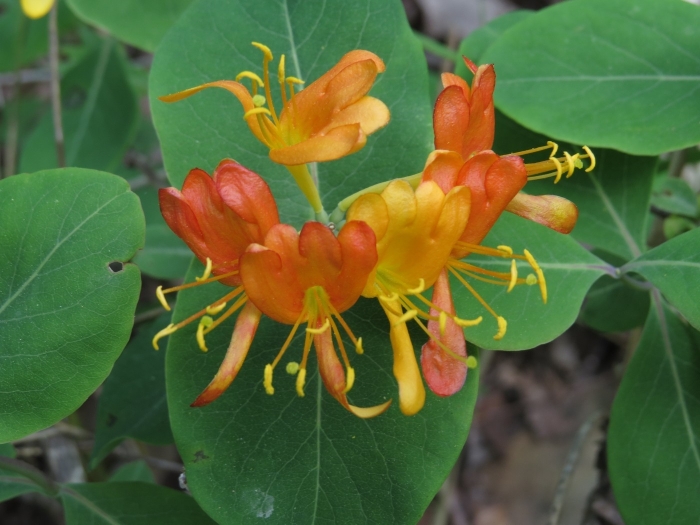Yellow Honeysuckle
(Lonicera flava)
Yellow Honeysuckle (Lonicera flava)
/
/

Evan M. Raskin
CC BY 4.0
Image By:
Evan M. Raskin
Recorded By:
Copyright:
CC BY 4.0
Copyright Notice:
Photo by: Evan M. Raskin | License Type: CC BY 4.0 | License URL: http://creativecommons.org/licenses/by/4.0/ | Rights Holder: Evan M. Raskin | Publisher: iNaturalist | Date Created: 2018-05-02T17:31:48-07:00 |
















Estimated Native Range
Summary
Lonicera flava, commonly known as Yellow Honeysuckle, is a deciduous perennial vine or shrub native to the open woodlands and forest edges of the central and southeastern United States. It typically grows to a height of 10-20 feet (3-6.1 meters) and a width of 3-6 feet (0.9-1.8 meters). This species features pairs of tubular yellow to orange flowers that bloom in late spring, which are followed by translucent red berries that are attractive to birds. The flowers are moderately showy and emit a sweet fragrance, which can add sensory appeal to garden settings.
Yellow Honeysuckle is valued for its ease of maintenance and its ability to attract pollinators such as hummingbirds and butterflies. It is often used in gardens for trellises, fences, and as a naturalizing element in woodland gardens. It thrives in full sun to part shade and prefers moist, well-drained soils, but it is adaptable to a range of soil conditions. While generally disease-resistant, powdery mildew and leaf spots can occasionally affect the plant. It is not known to be invasive and does not have aggressive roots, making it a good choice for residential gardens.CC BY-SA 4.0
Yellow Honeysuckle is valued for its ease of maintenance and its ability to attract pollinators such as hummingbirds and butterflies. It is often used in gardens for trellises, fences, and as a naturalizing element in woodland gardens. It thrives in full sun to part shade and prefers moist, well-drained soils, but it is adaptable to a range of soil conditions. While generally disease-resistant, powdery mildew and leaf spots can occasionally affect the plant. It is not known to be invasive and does not have aggressive roots, making it a good choice for residential gardens.CC BY-SA 4.0
Plant Description
- Plant Type: Vine
- Height: 10-20 feet
- Width: 3-6 feet
- Growth Rate: Moderate
- Flower Color: Yellow
- Flowering Season: Spring
- Leaf Retention: Deciduous
Growth Requirements
- Sun: Full Sun, Part Shade
- Water: Medium
- Drainage: Medium, Fast
Common Uses
Bee Garden, Bird Garden, Butterfly Garden, Deer Resistant, Drought Tolerant, Fragrant, Hummingbird Garden, Low Maintenance, Showy Flowers
Natural Habitat
native to the open woodlands and forest edges of the central and southeastern United States
Other Names
Common Names:
Scientific Names: , Lonicera flava, Lonicera flavida, Lonicera flava var. flavescens, Caprifolium flavum, Lonicera fraseri, Caprifolium fraseri,
GBIF Accepted Name: Lonicera flava Sims